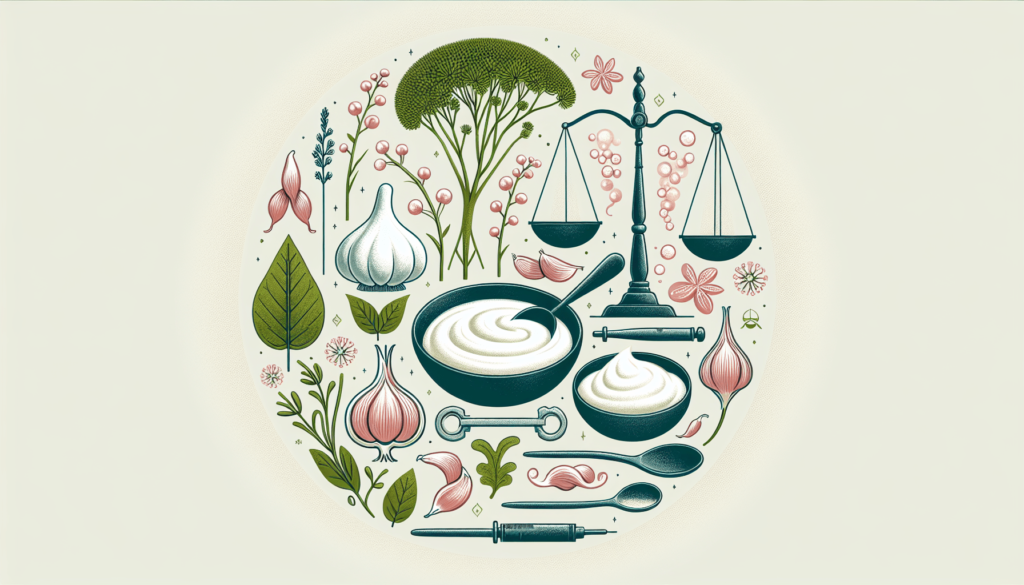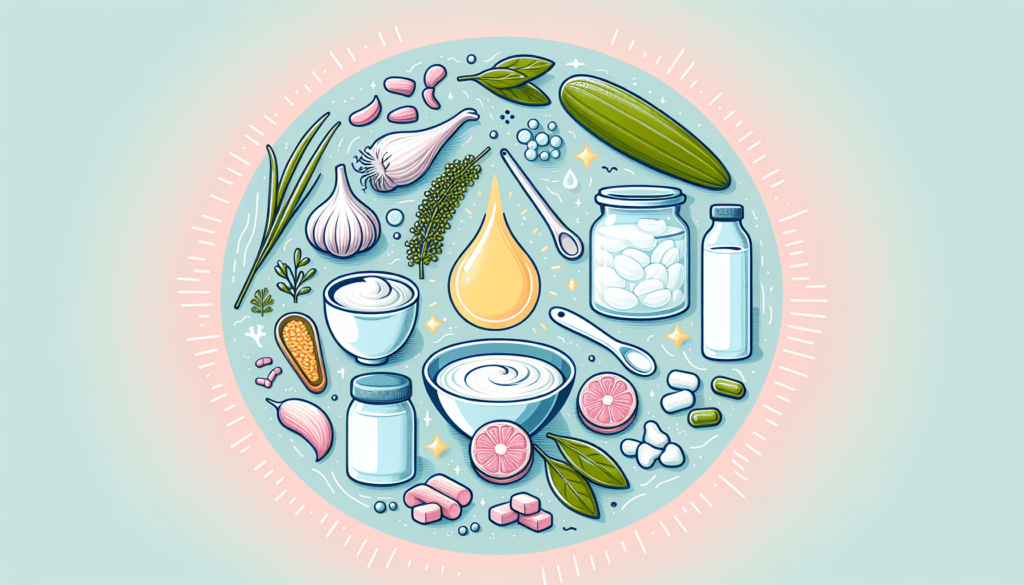Are you looking for safe and effective home remedies to address bacterial vaginosis? Look no further! In this article, we will explore various natural remedies that can help alleviate the symptoms of this common condition. From probiotics to herbal remedies, we will guide you through the options and provide you with valuable information on how to find relief from bacterial vaginosis discomfort right in the comfort of your own home. So, read on to discover some tried-and-tested remedies that may just be the solution you’ve been searching for.
Probiotics
Yogurt
Yogurt is a popular home remedy for bacterial vaginosis. It contains live cultures of beneficial bacteria, such as Lactobacillus acidophilus, which help restore the natural balance of bacteria in the vagina. Consuming yogurt regularly can promote the growth of these healthy bacteria and reduce the risk of bacterial vaginosis.
To use yogurt as a remedy, simply incorporate it into your daily diet. Opt for plain, unsweetened yogurt that contains live cultures, as added sugars can potentially worsen bacterial vaginosis symptoms. You can enjoy yogurt on its own, use it as a base for smoothies, or mix it with fruits and nuts for a nutritious snack.
Probiotic Supplements
In addition to yogurt, probiotic supplements can also be beneficial in treating bacterial vaginosis. These supplements contain a variety of beneficial bacteria strains that can help restore the natural flora of the vagina. Look for supplements specifically formulated for vaginal health, as they often contain strains like Lactobacillus crispatus or Lactobacillus rhamnosus.
When taking probiotic supplements, follow the recommended dosage instructions provided by the manufacturer. It’s important to note that the effectiveness of probiotic supplements may vary, so it’s advisable to consult with your healthcare provider before starting any new supplement regimen.
Tea Tree Oil
Diluted Tea Tree Oil
Tea tree oil has antimicrobial properties that can help eliminate the bacteria causing bacterial vaginosis. However, it’s important to dilute tea tree oil before using it as a remedy, as applying it directly to the skin can cause irritation. Mix a few drops of tea tree oil with a carrier oil, such as coconut or almond oil, to create a gentle solution.
To use diluted tea tree oil, apply a small amount to a clean tampon and insert it into the vagina. Leave it in for a few hours, then remove it. It’s crucial to dilute the oil properly and avoid using it on broken skin to prevent any adverse reactions.
Tea Tree Oil Bath
Another way to use tea tree oil for bacterial vaginosis is by adding a few drops to a warm bath. Fill the bathtub with warm water and add a few drops of diluted tea tree oil. Soak in the bath for 20-30 minutes, allowing the tea tree oil to come into contact with the affected area. Remember to rinse the genital area with clean water afterward to remove any residue.
Garlic
Garlic Cloves
Garlic is known for its antimicrobial and antifungal properties, which can help combat the bacteria causing bacterial vaginosis. To use garlic as a home remedy, peel a fresh garlic clove and wrap it in a clean medical gauze or cheesecloth. Insert the wrapped garlic clove into the vagina and leave it in for a few hours. Repeat this process daily until the symptoms improve.
It’s important to note that garlic may cause irritation for some individuals. If you experience any discomfort or increased irritation, discontinue use and consult with a healthcare professional.
Garlic Supplements
If the idea of using garlic directly in the vagina is unappealing or uncomfortable, garlic supplements may be an alternative option. These supplements typically come in the form of odorless capsules or tablets. They contain concentrated amounts of garlic extract, which can be effective in treating bacterial vaginosis.
When using garlic supplements, follow the recommended dosage instructions provided by the manufacturer. It’s also advisable to consult with a healthcare professional before starting any new supplement regimen, especially if you have any underlying medical conditions or are currently taking medication.
Apple Cider Vinegar
Apple Cider Vinegar Bath
Apple cider vinegar is a natural remedy that can help restore the pH balance of the vagina and eliminate harmful bacteria. To take an apple cider vinegar bath, fill a bathtub with warm water and add one to two cups of raw, unfiltered apple cider vinegar. Soak in the bath for 20-30 minutes.
It’s important to note that apple cider vinegar may cause a stinging sensation or irritation for some individuals. If you experience any discomfort, rinse the genital area with clean water and discontinue use. It’s also crucial to avoid using apple cider vinegar on broken or irritated skin.
Apple Cider Vinegar Douche
Using an apple cider vinegar douche can also be an effective way to treat bacterial vaginosis. Mix one to two tablespoons of raw, unfiltered apple cider vinegar with one cup of warm water. Use a douche kit or a clean, sterile syringe to gently flush the mixture into the vagina. It’s recommended to perform this douche once a day for several days until the symptoms subside.
Douching should be done with caution, as excessive or incorrect use can disrupt the natural balance of bacteria and cause additional problems. It’s advisable to consult with a healthcare provider before attempting a vinegar douche, especially if you have any underlying health conditions.
Boric Acid Suppositories
Using Boric Acid Suppositories
Boric acid suppositories have been used as a home remedy for bacterial vaginosis for many years. They have antifungal and antibacterial properties that can help restore the natural balance of the vagina. You can purchase boric acid suppositories at most drugstores or pharmacies, or you can make them at home by filling size 00 gelatin capsules with boric acid powder.
To use boric acid suppositories, insert one suppository into the vagina before bedtime. Leave it in overnight, and repeat this process for seven to fourteen days. It’s important to adhere to the recommended usage and duration, as excessive use of boric acid can cause irritation.
It’s crucial to note that boric acid suppositories should not be ingested or used during pregnancy. Consult with a healthcare provider before using boric acid suppositories to ensure their safety and effectiveness for your specific situation.
Hydrogen Peroxide
Diluted Hydrogen Peroxide Wash
Hydrogen peroxide is a disinfecting agent that can help eliminate harmful bacteria in the vagina. It’s important to dilute hydrogen peroxide before using it as a wash to prevent any potential irritation. Mix one part hydrogen peroxide with three parts water to create a diluted solution.
To use the diluted hydrogen peroxide wash, pour the solution into a clean spray bottle or use a clean, sterile syringe to gently flush the mixture into the vagina. It’s recommended to perform this wash once a day for several days until the symptoms improve.
Remember to discontinue use if you experience any discomfort or increased irritation. It’s advisable to consult with a healthcare professional before using hydrogen peroxide as a remedy, especially if you have any underlying medical conditions.
Fenugreek
Fenugreek Water
Fenugreek is an herb that has been used for its medicinal properties for centuries. It contains compounds that have antimicrobial and anti-inflammatory effects, making it a potential home remedy for bacterial vaginosis. To make fenugreek water, soak a teaspoon of fenugreek seeds in a glass of water overnight. Strain the water in the morning and drink it on an empty stomach.
Drinking fenugreek water daily can help promote a healthy vaginal environment and reduce bacterial overgrowth. However, it’s important to note that fenugreek may interact with certain medications or have side effects, such as gastrointestinal discomfort. It’s advisable to consult with a healthcare provider before using fenugreek as a remedy, especially if you have any underlying medical conditions.
Tea
Herbal Tea
Certain herbal teas can help soothe the symptoms of bacterial vaginosis and promote a healthy vaginal environment. Chamomile, calendula, and rosemary teas are known for their antimicrobial and anti-inflammatory properties, which can help fight bacterial overgrowth and reduce inflammation. Additionally, herbal teas can have a calming effect on the body, which can aid in relaxation and stress reduction.
To enjoy herbal teas, steep a tea bag or a teaspoon of dried herbs in a cup of hot water for about 10 minutes. Strain the tea and drink it while it’s warm. You can enjoy herbal tea multiple times a day to experience its benefits. However, it’s important to avoid adding sweeteners, such as sugar or honey, as these can potentially worsen bacterial vaginosis symptoms.

Cranberry Juice
Consuming Cranberry Juice
Cranberry juice is often recommended as a natural remedy for urinary tract infections, but it can also be beneficial for bacterial vaginosis. Cranberries contain compounds that can help prevent bacteria from adhering to the walls of the urinary and vaginal tracts. This makes it harder for the bacteria to multiply and cause infections.
To incorporate cranberry juice into your daily routine, opt for unsweetened, pure cranberry juice or cranberry concentrate. Dilute it with water if needed, as pure cranberry juice can be quite tart. Drink a glass of cranberry juice daily to potentially reduce the risk of bacterial vaginosis.
It’s important to note that cranberry juice is not a cure for bacterial vaginosis, but it may act as a preventive measure or help alleviate symptoms. If you already have bacterial vaginosis, it’s advisable to combine cranberry juice with other remedies for better results.
Maintaining Good Hygiene
Avoiding Harsh Soaps
When dealing with bacterial vaginosis, it’s essential to avoid using harsh soaps or cleansers in the genital area. These products can disrupt the natural pH balance and irritate the delicate tissues. Opt for mild, fragrance-free soaps or cleansers specifically formulated for intimate hygiene.
Washing with Mild Cleansers
To maintain good hygiene and prevent bacterial vaginosis, it’s important to wash the genital area with mild cleansers regularly. Gently clean the external genital area with warm water and a mild, unscented soap or cleanser. Avoid excessive scrubbing or using any harsh ingredients that may cause irritation.
Avoiding Douching
Douching, or the practice of cleaning the vagina with water or other solutions, can disrupt the natural balance of bacteria and potentially worsen bacterial vaginosis. It’s best to avoid douching altogether, as the vagina is self-cleaning and does not require additional cleansing.
Wearing Loose-Fitting Clothing
Tight-fitting clothing, especially synthetic materials, can trap moisture and heat, creating an environment conducive to bacterial overgrowth. To prevent bacterial vaginosis, opt for loose-fitting clothing made from breathable fabrics like cotton. This allows air circulation and helps keep the genital area dry and ventilated.
Changing Out of Wet Clothes
Staying in damp or wet clothing for extended periods can promote bacterial growth and increase the risk of infections, including bacterial vaginosis. Change out of wet bathing suits, sweaty workout clothes, or damp undergarments as soon as possible. It’s important to keep the genital area dry and clean to prevent bacteria from thriving.
By incorporating these bacterial vaginosis home remedies into your routine and adopting good hygiene practices, you can potentially alleviate symptoms, prevent future flare-ups, and maintain a healthy vaginal environment. Remember, it’s always advisable to consult with a healthcare provider before attempting any home remedies, especially if you have any underlying medical conditions or are currently taking medication.



